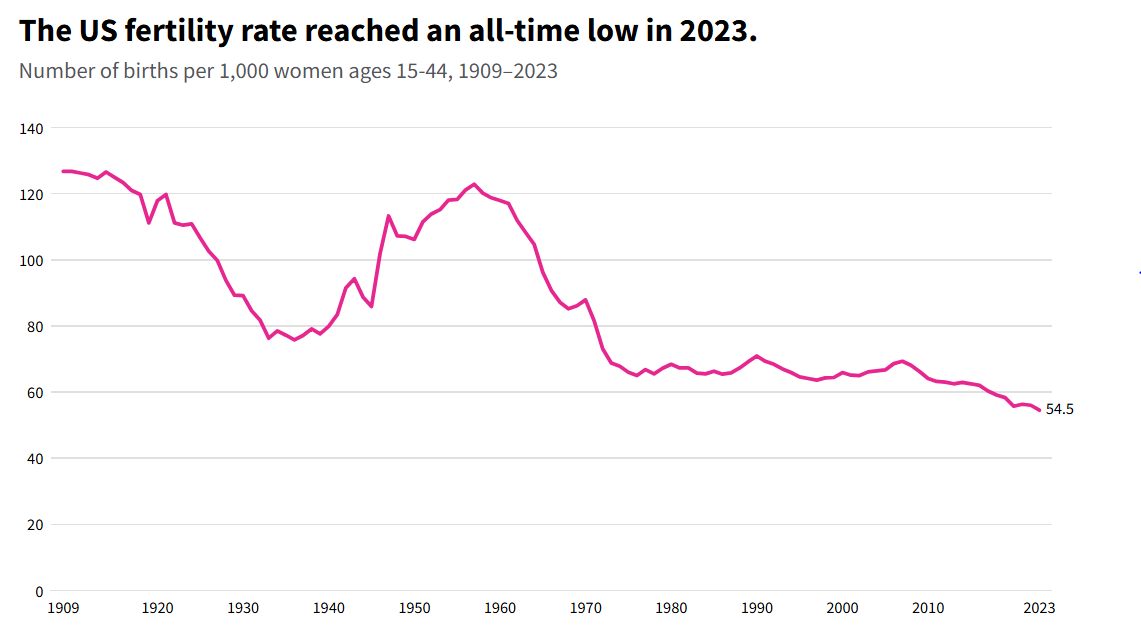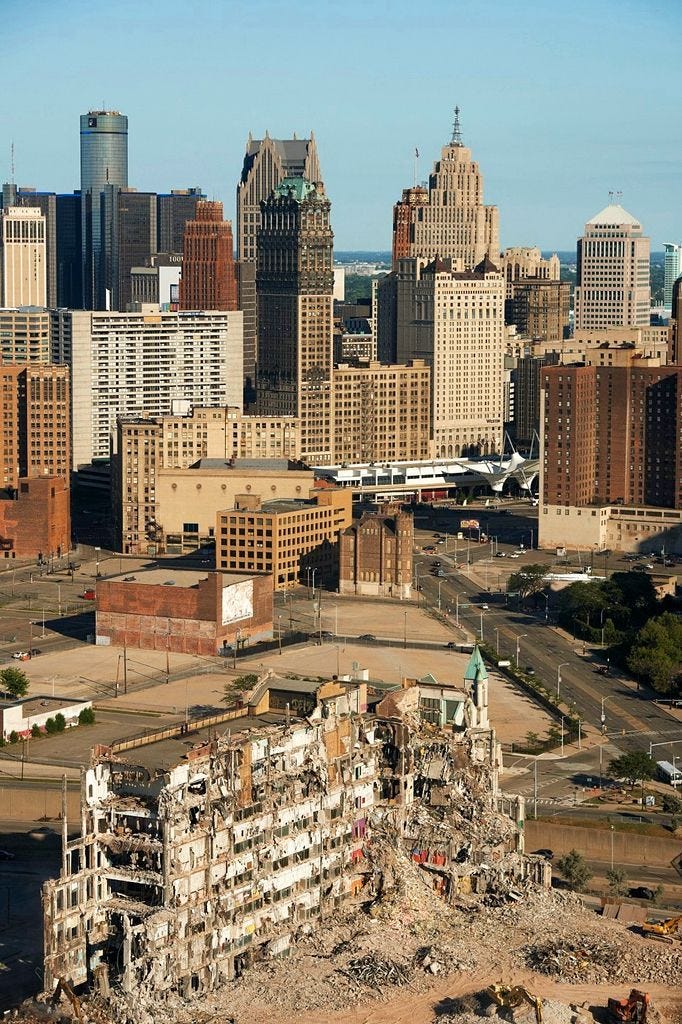America has suffered from half a century of deindustrialization, driven by government and corporate focus on short term optimization to bribe shareholders and voters. If there had been a vision driving the process, it would have been an end state where Americans hold bullshit jobs in the private and government sectors, while all the stuff they consume is produced elsewhere in exchange for US dollars. Even the biorobots needed to do the physical work which must be done within American borders-running the stockyards, kindergartens and nursing homes-would be born and raised elsewhere and imported as adults. This is the logic of every empire: the metropole is hollowed out by cheap or free imports from the colonies, funneled and distributed through a metropolitan elite to an ever dumber, lazier and more loathsome underclass which owns nothing and is happy. That’s how the Roman Empire ended, with bread grown by slaves on latifundia and distributed to the urban mob, which would take its full bellies to the circus to watch other slaves slaughter each other.
The inevitable result is human capital collapse, manifesting in deindustrialization: a core population capable only of consuming, which neither wants to make anything nor can do so, for structural and moral reasons. Trump’s policies are aimed at reversing this process, in a twofold approach. First, DOGE is destroying the governmental structures which create regulatory barriers to industry. Second, tariffs are artificially raising the prices of imported goods, encouraging the creation of American businesses producing substitutes. Conversely, American tariffs provide an incentive for other countries to lift the tariffs they’ve been imposing on American goods, stimulating increased consumption of those goods and thus their production.
Having an actual national industrial policy explicitly optimized for the long term national interest is a novel experience for Americans. The previous model involved national policy in the service of big profits for politically connected oligarchs along with modest short term payoffs for the normies, resulting in a series of local optima…
…interspersed with crashes requiring bailouts.
This is exactly analogous to a junkie who either feels good because he’s full of heroin, or bad because he’s not. Either way, the problem is lack of heroin and more heroin is the solution. So, a market drop in response to the tariffs without the money printer immediately going brrr is interpreted as a sign of the policy’s failure and results in loud calls for it to be rolled back. This junkie logic is no way to make policy-in fact, it’s how the US got here in the first place.
The more interesting question is whether it’s not too late for all this stuff to do any good. Is the patient only mostly dead? Or is he all the way dead?
Maybe, the patient is undead. After a few years, the last thing you want to do is to stop with the heroin-it’s all that’s keeping him going.
Deindustrialization has been done at least once before. The industrial plants of the Russian empire had been abandoned for a decade after the Revolution; the engineers, workers, foremen had fled or died. The USSR had to reindustrialize and modernize on a national scale, or face defeat in the coming war. They did this in a decade, at great cost. Millions were killed, many millions more had their lives ruined. The Soviets relied on foreign expertise and equipment, bought with foreign currency and art they squeezed out of their population and churches. They sold the West natural resources extracted by starving, dying armies of their slaves. Their managerial apparatus was full of former revolutionaries, professional conspirators; their workforce of people who hated the regime and had extensive experience in civil war and insurrection. They lacked modern Western managerial techniques, and had to rely on a mix of terror and propaganda for motivation. Private capital allocation was nonexistent, as were enrichment opportunities for entrepreneurs. Computers did not exist, so everything had to be drafted and produced by manually operated machinery. Much of the workforce was illiterate and had never owned a watch. Brutal, systemic inefficiency reined. And yet in a decade the USSR was remade as an industrial juggernaut, capable of outproducing Germany and the UK in tanks, planes and artillery.
Compared to the Soviet challenge, American reindustrialization is a much simpler task. America is a wealthy country with a somewhat literate and numerate population used to the rule of law (state-sponsored riots aside.) Modern managerial techniques and private capital allow efficient resource allocation and management. Computerized tools allow a quicker learning curve and better leverage for a trained workforce. Perhaps most importantly, the US has millions of expert engineers, designers and machinists in their 50s-80s. Many of the men who built the spaceships, jet planes and oceanic fleets of America’s heyday are alive and of sound mind, and would be glad to have a chance to mentor the next generation.
The degree to which this process would require central planning is questionable. I think that a favorable business climate-high internal demand, loans on favorable terms, low tax and regulatory burdens-would pull manufacturing entrepreneurship out of the American population very quickly. Keystone enterprises like Tesla would stimulate the emergence of ecosystems of subcontractors and suppliers within a few years. Maybe American conglomerates, the equivalents of chaebols and keiretsus will emerge; maybe the Chinese style overlapping industrial ecosystems with multiple competitors at every level trying to serve the needs of their customers.
The big question is whether there are enough young Americans who are capable of and willing to work in manufacturing. This is not drudge labor for biorobots. Machine processes are highly automated and getting more automated all the time. This is true even for sewing, the industry which gave sweatshops their name. In high wage countries like the US, the increased cost of labor results in a proportionately higher investment in capital, which in turn increases labor’s productivity and wages, a virtuous cycle described by Edward Luttwak in The Endangered American Dream. When I toured the small manufacturing operations of Iowa a decade ago, I noticed two things: first, they were quite sophisticated and productive: factories in towns of 5,000 people running advanced roboticized operations with 3d printing, six axis CNC mills and robotic loading and unloading cells. Second, employees were, on average, middle aged.
Reindustrialization requires a large population of literate, numerate, healthy, diligent young men and women to learn advanced technical skills and apply them consistently and independently, day in and day out, for years and decades, in exchange for high pay, good work conditions and the opportunity to do an unglamorous but important and honorable job. This population is exactly what has been decimated over the last sixty years by American education and mass culture. The quantity of American youth has collapsed:
Quality (intellectual, moral and physical) has also plunged. A decade ago, only a third of American adults were functionally numerate to the degree needed to work in advanced manufacturing. I would guess that the percentage of numerate youth was lower back then. Today, after a decade of educational collapse, I’d guesstimate 20% of Americans in their 20s and 30s are numerate enough to learn how to turn drawings and 3D models into machine instructions and precise parts. Morally, they’ve been raised by an entertainment ecosystem which promotes savagery and worships instant gratification; the opposite values of the patience, attention to detail and gumption required for productive work. And while manufacturing does not require strenuous physical exertion, it does require a baseline of health and mobility which perhaps half of American youth lack.
With all of the above taken into consideration, I’d guess that around 10% of the 80 million or so Americans aged 15-34 are capable of working in advanced manufacturing. Some significant fraction of them are currently underemployed, working as barristas and tire changers, studying sociology at their local community college and so on. So there are millions available to be brought online. Objectively, this is not a negligible pool; at the height of WW2, there were 16 million Americans employed in manufacturing, and though they had no access to computers or automation, they built the machinery that conquered the planet. On the other hand, compared to the more than 100 million Chinese working in manufacturing, the number is small.
The bottom line is that America has nothing to lose in the big picture. The alternative to reindustrialization is continued deindustrialization, a service economy gradually moving into one entirely driven by government handouts, and collapse of human capital. You can either move in the direction of 1920 Detroit or 2025 Detroit. There is no other option.










Lack of Youth;
“employees were, on average, middle aged. “
That’s because they’re in college, wondering what they’re doing there…
Thank you for this article.
To answer the Title: Yes.
We never really completely De-Industrialized and we’ve been Reshoring for years.
We 🇺🇸 have been lied to and demoralized and told “it’s inevitable” by the managed decline crowd, who literally have been betting against us.
Oh and they went into debt to gamble so…. They are losing.
We’ve been reshoring for years, we certainly have the resources and people and infrastructure.
Links unto Spam available on request.